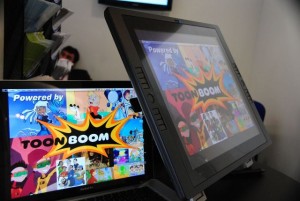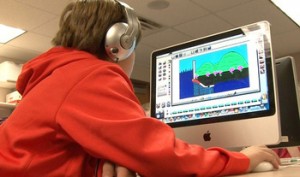 Joan Vogelesang, is someone whom many Indian animation pioneers look up to as a mentor and expert in the field of animation. She is also the president and CEO of Toon Boom. She sits on Toon Boom’s Board of Directors and under her leadership; Toon Boom continues to maintain its position as a world leader in animation technology.
Joan Vogelesang, is someone whom many Indian animation pioneers look up to as a mentor and expert in the field of animation. She is also the president and CEO of Toon Boom. She sits on Toon Boom’s Board of Directors and under her leadership; Toon Boom continues to maintain its position as a world leader in animation technology.
With well over 30 years of experience as a senior executive responsible for international business development, customer care and operational management in large and smaller organisations; Vogelesang is regularly invited as a guest speaker at international animation events. These include Asia Animation Conference, ChangZhou Animation Festival, HangZhou Animation Festival, eLearning Africa, FRAMES and NASSCOM Animation India.
Her association with Indian animation continues till date and in 2004, the Federation of Indian Chambers of Commerce & Industry honoured Vogelesang with the Life Time Achievement Award for promoting the Indian Animation Sector on the global map.
The globetrotting CEO managed to take out some time off her busy schedule and share her thoughts with AnimationXpress.com’s Sidharth Iyer in a heart to heart e-mail interaction on the future of the Indian animation industry and where it stands currently…
Excerpts:-
You have seen the Indian animation industry upfront, close and personal for several decades now. Can you give us an outsider’s perspective on it?
A decade ago, India had a great opportunity to take a leadership role for outsourcing opportunities, as well as developing the skill to create local content for export. However, India missed the opportunity due to lack of training on a large scale to prepare the workforce as per international standards. In addition, the focus was more on 3D and productions that did not meet international standards, except for one or two studios.
The opportunity was missed then but is now regenerated through education at the elementary and secondary levels.
What are some of the positive initiatives that the Indian animation industry has made over the years?
A couple of very strong studios emerged over the years and carved themselves an impressive reputation internationally, not only in terms of outsourcing within India and overseas but also investing in productions.
Education still needs to be addressed to get the workforce well-trained and market-ready.
Which initiatives have harmed the cause of the Indian animation industry?
Mostly, it is the lack of education in animation concepts, storytelling, and production pipeline delivered to a broad enough group to supply the industry. Another element relates to the mindset of keeping up to date with training and technology, as both evolve rapidly due to market requirements. Lastly, the fact that studios are competing among themselves instead of competing as a cohesive group internationally, along with using pirated technology has hampered them a lot.
What is needed to get the Indian animation industry on the growth track?
Primarily, it would be to develop a well-trained workforce and have entrepreneurial stakeholders invest in infrastructure. Secondly, it is important to connect studios to work internationally within co-productions and content development that is exportable. Toon Boom has a methodology that has been implemented in other countries and has proven to be successful. There are not enough people to fill the studios and not enough studios to deliver content to broadcasters and netcasters such as Netflix.
Can you talk about some of the successful animation studios in India and discuss their strengths and the work they have produced?
DQ out of Hyderabad has emerged as a leader in both outsourcing and IP development. Early on, they focused on staff development by bringing outside experts to transfer the knowledge and continued developing their skills to be proficient in different techniques. Their leadership is tremendous; Tapaas is known internationally and has worked very hard to gain their current reputation.
Toonz Animation out of Trivandrum is another strong player, mostly known for their investment and development of IP, as well as their hiring of outsourcing studios within India and outside. In the past, they organised an event called “Week with the Masters”, introducing international animators to the local community and exposing them to established animation concepts and quality requirements. Jayakumar and his team worked hard to maintain a high-profile reputation globally.
There are many others that are doing excellent work, such as Technicolor India headed by Biren Ghose out of Bangalore. They provide very good services to Technicolor International. Biren has a thorough understanding of the industry and his credibility is very well established.
One of the big advantages these studios have is their fiercely entrepreneurial quality and nature, which bode very well for the future.
How would you rate the animation industries in some of the southeast Asian countries and China as compared to the Indian animation industry?
The Philippines and South Korea are very well recognised for the quality of their workforce and production throughout compared to China, where the tremendous investment in infrastructure and training is not paired with quality as per international standards. DeTao Master Academy is paving the way to significantly up the storytelling capabilities and production quality. They have initiated a significant transfer of skills and invested in manpower but still, quality standards are not yet met.
In India, even though the investment in manpower is not backed by government, there are still pockets of expertise nurtured by the entrepreneurial nature of key stakeholders. India is well positioned to moving forward and getting the sector up in a timely fashion. In India, it is quite common to have most senior visitors meet and talk to the junior staff while visiting the premises. It is a great benefit to share information in an open society.
Can India break out and become a global animation force?
Absolutely; all the pieces are there. They need a strong business group or association that wants to make it happen and move forward as a team. Creative industries, of which animation is a significant part, can represent a significant pillar in the economy and translates to job creation and the generation of export earnings.
Here are some stats:
In Quebec, Canada: Creative industries provided Montreal with 91,500 jobs in 2012 and generated economic benefits of $8.6 billion for the greater Montreal region.
The average rate of job creation in the creative industries was more than twice of that seen in the average Montreal economy in recent years.
Self-employed workers account for 25 per cent of total jobs in the creative economy compared to 11 per cent overall.
Montreal ranked seventh out of 21 North American cities in terms of the importance of the creative industries to its economy. In Montreal, 3.5 per cent of the workforce is working in creative industries, behind front-runners like Seattle and New York, but neck and neck with Toronto and Vancouver, and ahead of cities like Chicago, San Diego and Boston.
In Ontario, Canada: Creative industries support more than 300,000 jobs 1,000 digital media companies employ16,000 people and generate about $1.2 billion in revenue.
Film and television production companies account for 30,000 jobs and contributed $1.3 billion to the economy in 2011.
 In the UK: The creative sector accounted for $1.6 of every $15.6 of British export. British creative industries generate close to $109,000 every minute.
In the UK: The creative sector accounted for $1.6 of every $15.6 of British export. British creative industries generate close to $109,000 every minute.
It is worth mentioning that animation technologies are now used within the educational system from elementary to secondary to teach all subjects. Not only does it keep students engaged and motivated to learn, it opens up career options and prepares them to pursue their education in the field to join the creative and digital communication market.
How is Toon Boom faring in India? Which software technologies have found traction and why? Do you see a large market for it in the coming years? What steps are you taking to meet your expectations?
Toon Boom has had cyclical success in India and continues to be active. The future is positive. We see great interest in our 2D-3D integration capabilities, which is the style mostly chosen for gaming and consumer products. We are at the studio level as well as in education throughout all levels up to training for jobs.
Are you still bullish on India? Why?
Absolutely. It is necessary. India is a huge force for the future in many different sectors. We feel extremely optimistic from Toon Boom’s perspective and are with the industry.



